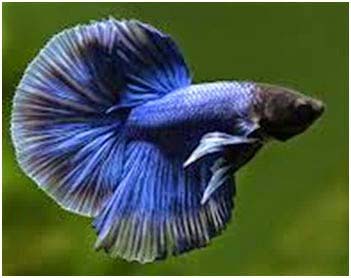
Betta fish
Introduction
The betta fish is a very popular aquarium fish due to their brightly colored body and elaborate fin which is also known as Siamese fighting fish. It is native to the Mekong basin of Thailand, Laos, Cambodia and Vietnam. It inhabits in standing waters of canals, floodplains, thickly overgrown ponds and in very slowly flowing waters such as shallow paddy fields, stagnant pools, polluted streams and a low-oxygen content areas. It prefers a warmer water temperature than other tropical fish which ranges from 75-86° F.
Overview
The brilliant coloration and long flowing fins of the betta fish makes it one of the most well known of aquarium fish. The betta fish has torpedo shaped body with an upturned mouth and short rounded fins. Body is dull green and brown in color. Male is typically more brilliantly colored and has long flowing fins. It also has a more distinct beard and is larger overall than the female. The female has short fins and displays vertical stripes and an egg spot when ready to mate. It is carnivorous fish and in the wild condition, it mainly feeds on zooplankton, crustaceans, the larvae of mosquitoes and other water-bound insects. Due to its small size, bright colors and long, attractive fins, it is preyed upon by many predators like larger fish, cats, newts, salamanders, birds etc. Betta splendens can reach sexual maturity at the age between 4 and 5 months. It grows up to 7 cm in length and it can live up to 10 years.
Background
The Betta fish or Siamese fighting fish was described by Regan in 1910. It is a perch like ray finned fish which belongs to the family Osphronemidae under order Perciformes of class Actinoperygii. The genus name ‘Betta’ was taken from the Javanese name ‘Wuder Bettah’”. Other common names of betta include Split-Tailed Betta and Libby Betta. In Thailand, it is called “pla-kat” which means Fighting Fish. This species is now listed on the IUCN Red Data Book as Vulnerable species (VU).
Quick Stats
Scientific Name: Betta splendens
Common Name: Betta, Siamese fighting fish
Origin: Cambodia, Thailand
Adult Size: 3 inches (7 cm)
Behavior: Peaceful
Tank Level: Top dweller
Minimum Tank Size: 3 gallons
Diet: Carnivore
Breeding: Egg layer
Care level: Easy to Intermediate
Water pH: 6.8 – 7.4
Water Hardness: up to 20 dGH
Water Temperature: 75-86 ° F
Water Movement: Moderate – normal
Lighting: Moderate – normal lighting
Lifespan: up to 10 years
Housing
The betta fish is probably the second most popular fish after Goldfish. It is a favorite due to its beauty, long fins and is relatively easy to care for. It requires 3 gallons tank for a single fish but 10 gallons or larger aquarium is recommended. It is a peaceful fish which can be kept with other peaceful species of fish such as Tiger Barbs. They become aggressive with other bettas and tropical fish with large fins such as guppies, angelfish and others. They are hardy fish and can adapt to most aquarium conditions and their special ‘labyrinth organ’ enables them to survive in oxygen-depleted waters. This species does best in a well-planted and shady tank with plenty of surface areas. The plants should be floating types such as Salvinia or Riccia species or tropical lilies such as Nymphaea. Driftwood, other plants such as Microsorum or Taxiphyllum species, small clay plant pots, plastic pipes or empty camera film cases can also be included to provide extra shelter.
Feeding
The betta or Siamese fighting fish has upturned mouth and it is primarily carnivorous surface feeder. In the wild condition, it mainly feeds on zooplankton, crustaceans, the larvae of mosquitoes and other water-bound insects. In captive condition, it should be fed commercial betta pellets. It also accepts small live or frozen invertebrates and small fish. The feed should be supplied couple of times a day.
Breeding
Like many gouramis, the Siamese fighting fish is bubble breeder and the male builds bubble nest of various sizes and thicknesses at the surface of the water. They breed in bubble nests and do not require a large tank or special equipment. Ideally the fish should be conditioned prior to breeding by feeding them a diet of live foods. The water should be at a pH of about 7.0 and temperature around 80 0F or slightly above. The female should be provided with a hiding place before spawning. The female lays around 10–40 eggs during each embrace. The male releases milt into the water and fertilization takes place externally. During and after spawning, the male uses his mouth to retrieve sinking eggs and deposit them in the bubble nest. After spawning, the male guards the nest, taking care of the eggs until the young hatch 24 to 48 hours later. Newly hatched larvae remain in the nest for the next two to three days until their yolk sacs are fully absorbed. Afterwards, the fry leave the nest and the free-swimming stage begins. In this first period of their lives, the fry are totally dependent on their gills and the labyrinth organ to breathe atmospheric oxygen. The male should be removed within two days after the fry hatch to prevent them from eating eggs. The fry should be fed with baby brine shrimp or very fine baby food. The feed should be offered two times daily.
Sexing
It is easy to sex. Male is typically more brilliantly colored and has long flowing fins. It also has a more distinct beard and is larger overall than the female. Female has short fins and displays vertical stripes and an egg spot when ready to mate.
Concluding Remarks
Betta splendens is the most popular fish for a beginning aquarium enthusiast. It is quite disease resistant, very resilient, readily available and inexpensive.
Written specially and exclusively by Dr. A. K. M. Nazrul Kabir, Associate Professor, Zoology.

